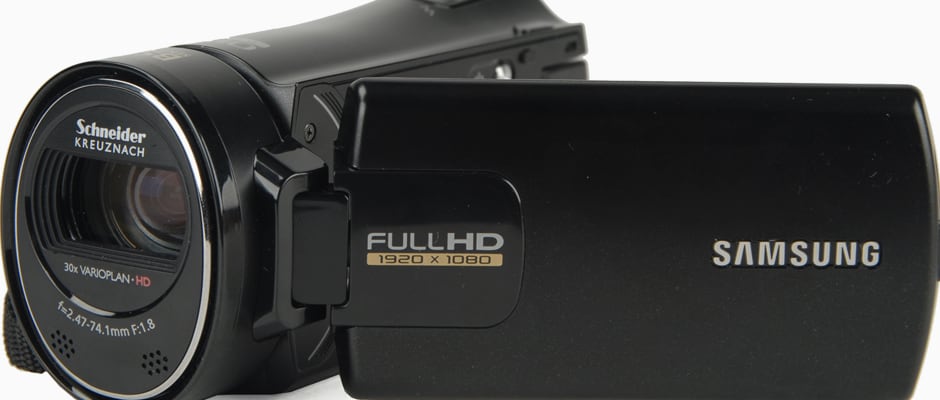Pros
Cons
Introduction
Front
{{section_header}}{{section.name}}{{/section_header}}

Back
{{section_header}}{{section.name}}{{/section_header}}

Left
{{section_header}}{{section.name}}{{/section_header}}
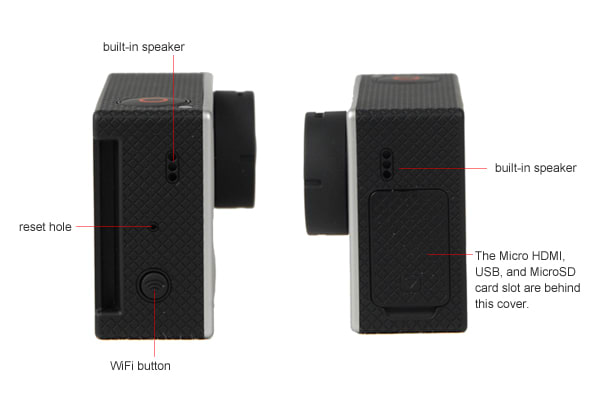
Right
{{section_header}}{{section.name}}{{/section_header}}
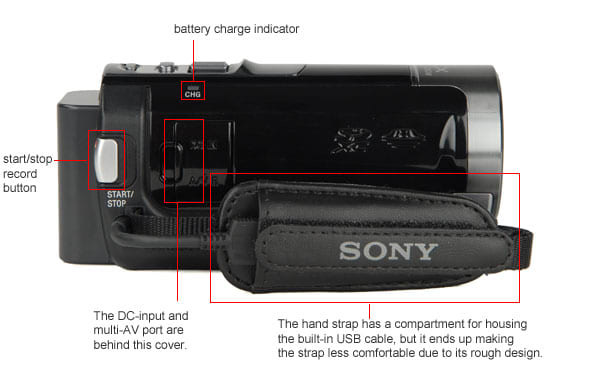
Top
{{section_header}}{{section.name}}{{/section_header}}

Bottom
{{section_header}}{{section.name}}{{/section_header}}

In the Box
{{section_header}}{{section.name}}{{/section_header}}

The Samsung HMX-H300 comes with the following accessories:
• AC adapter
• BP210R rechargeable battery pack
• AV cable
• USB cable
• instruction manual
Color
{{section_header}}{{section.name}}{{/section_header}}
The Samsung HMX-H300 had trouble producing accurate colors in our bright light test, and the test images we captured looked dull and muted. The camcorder's hard numbers in this test came to a color error of 6.33 and a saturation level of 90%. This color error number is far worse than the competition, including the score achieved by last year's Samsung HMX-H200 (the model the H300 was designed to replace). More on how we test color.
To top it all off, the H300 has no color modes or picture adjustment options that let you tool with the colors recorded by the camcorder. This means the colors you see in auto mode are the colors you're going to be saddled with in all record modes. Of course, colors will change depending on the kind of lighting you use, and the type of white balance system you employ. We do all of our testing with a manual white balance in an effort to obtain the best color accuracy possible with the camcorder.
Looking at the color error map taken from our testing (that image with the circles with lines attached), you can see that the HMX-H300 rendered blue and purple colors with good accuracy. It was greens, yellows, and browns, however, that the camcorder had plenty of trouble with, thus lowering its overall color score. Since color quality is very much a matter of personal preference, we urge you to look through the crops and comparison images on this page to make up your own mind about the color performance of the H300 and the camcorders we compared it to.
{{comparison_bars title="Color Score Comparison", attribute="Color Score", xLabel="Color Score"}}
Low Light Color
{{section_header}}{{section.name}}{{/section_header}}
In terms of color accuracy, the H300 actually did better in our low light color test than it did in our bright light color tests. The camcorder managed a color error of just 4.9 in low light (compared to 6.33 in bright light), although its saturation level was around 75% (down from 90% in bright light). These scores represent the H300's best performance out of our three low light tests, but we wouldn't consider these scores any better than average for a mid-range model. More on how we test low light color.
The HMX-H300's video image in low light appeared a bit dark, as you can see by looking at the color error map above. Notice how the colors all move towards the center of the spectrum due to their darker tones. In comparison, the Panasonic HDC-TM90 had slightly worse color accuracy than the H300, but its saturation level was a lot higher (85%). The Canon HF M40 had the best color accuracy overall, while the Samsung HMX-H200 had the worst (and the lowest saturation level—59%).
Noise
{{section_header}}{{section.name}}{{/section_header}}
The HMX-H300 redeemed itself slightly with a good performance in our noise test. The camcorder averaged 0.67% noise in this test, which is less than what we saw from the Panasonic TM90 and Canon HF M40. Unfortunately, however, this is more noise than we measured on the HMX-H300's predecessor, the HMX-H200. Usually, we expect to see improvements in noise levels with new camcorders, as updates to processing and sensor technology occur. This was not the case with Samsung, though. More on how we test noise.
Cycling through the cropped images above, you should notice that the HMX-H300 did not capture video with the same level of sharpness as the competition. Numbers in the cropped image appear blurred, as do the lines near the bottom of the vertical trumpet. The fact that the H300 didn't capture as sharp of an image as the Panasonic TM90 or the Canon HF M41 isn't all that surprising, as those are two of the best mid-range camcorder's we've reviewed this year. What shocked us, however, was that the H300's video image was even less sharp than its predecessor's, the HMX-H200. Look at the crops and see for yourself if you don't believe us.
{{comparison_bars title="Noise Score Comparison", attribute="Noise Score", xLabel="Noise Score"}}
Low Light Sensitivity
{{section_header}}{{section.name}}{{/section_header}}
Since the Samsung HMX-H300 has a fairly wide angle of view for recording video, we tested its low light sensitivity both with and without using zoom. Fully zoomed out, with its widest aperture setting, the H300 needed 12 lux of light to record a broadcast-worthy image (or 50 IRE for those who care). This is a decent score, but the HMX-H300 needed nearly twice as much light to record an image with the same brightness when we zoomed in a bit. Zooming in to frame our test chart, the H300 required 23 lux of light to hit 50 IRE on our waveform monitor. More on how we test low light sensitivity.
Let's be clear: these scores aren't great, but they do represent a huge increase over last year's HMX-H200 (which needed 42 lux of light to reach the same light levels when using zoom). Both the Canon HF M40 and the Panasonic HDC-TM90 did a lot better than the H300 in this test, and both were better low light performers overall, as you'll see in the next two sections on this page.
{{comparison_bars title="Low Light Sensitivity Comparison", attribute="Low Light Sensitivity Score", xLabel="Low Light Sensitivity Score"}}
Low Light Noise
{{section_header}}{{section.name}}{{/section_header}}
Looking at the cropped image from our low light testing with the HMX-H300 (above), you'll quickly see just how bad the camcorder performed in low light environments. The camcorder produced a blurred, murky, and very noisy image in low light, as you can see from the crop below. The H300's noise levels were measured at 2.28%, which is roughly twice the amount of noise we measured from our three comparison models. More on how we test low light noise.
The pictures above really tell the story the best. Notice how terrible the H300's video image looks in low light compared to that of the Panasonic HDC-TM90 and Canon HF M40. Even more surprising is how much worse the H300's cropped image looks compared to what the Samsung H200 produced in low light. The HMX-H200's video image wasn't great by any means, but it certainly looks better than what the H300 produced. This test should be seen as a warning for anyone who wants to shoot in low light situations—stay away from the Samsung HMX-H300.
{{comparison_bars title="Low Light Noise Score Comparison", attribute="Low Light Noise Score", xLabel="Low Light Noise Score"}}
Low Light Color
{{section_header}}{{section.name}}{{/section_header}}
In terms of color accuracy, the H300 actually did better in our low light color test than it did in our bright light color tests. The camcorder managed a color error of just 4.9 in low light (compared to 6.33 in bright light), although its saturation level was around 75% (down from 90% in bright light). These scores represent the H300's best performance out of our three low light tests, but we wouldn't consider these scores any better than average for a mid-range model. More on how we test low light color.
The HMX-H300's video image in low light appeared a bit dark, as you can see by looking at the color error map above. Notice how the colors all move towards the center of the spectrum due to their darker tones. In comparison, the Panasonic HDC-TM90 had slightly worse color accuracy than the H300, but its saturation level was a lot higher (85%). The Canon HF M40 had the best color accuracy overall, while the Samsung HMX-H200 had the worst (and the lowest saturation level—59%).
Motion
{{section_header}}{{section.name}}{{/section_header}}
Overall, we didn't mind the way the Samsung HMX-H300 captured moving subjects. There were some problems with sharpness and clarity, but motion consistently looked smooth. Artifacting was more prominent than what we saw from the competition, but the amount was still very low. There was some discoloration and blur in both of the rotating pinwheels in our motion test as well, but, again, the presence of these traits wasn't all that distracting.
The H300 records all Full HD video using a 60i frame rate, but a 60p rate is used when shooting 1280 x 720 HD video. The camcorder does not have a slow motion mode, but it does offer a time lapse record setting. This lack of alternate frame rate options is one reason the Panasonic HDC-TM90 (Full HD 60p recording) and Canon HF M40 (24p and 30p recording) may be more appealing models for some users. More on how we test motion.
Video Sharpness
{{section_header}}{{section.name}}{{/section_header}}
The Samsung HMX-H300 did not capture video with the same level of sharpness as the competition from Panasonic and Canon. At best, the camcorder managed a horizontal sharpness of 750 lw/ph and a vertical sharpness of 550 lw/ph. These numbers are decent for a mid-range HD camcorder, but they are not in the upper echelon of camcorders, which is where we'd place the Canon HF M40 and Panasonic HDC-TM90 based on their sharpness results.
The most disappointing revelation from this sharpness test is the fact that the HMX-H300 did worse than its predecessor, the HMX-H200. The numbers weren't that much worse—only by 50 lw/ph both horizontally and vertically—but we never like to see a decrease in performance from a newer model. More on how we test video sharpness.
{{comparison_bars title="Video Sharpness Score Comparison", attribute="Video Sharpness Score", xLabel="Video Sharpness Score"}}
Ease of Use
{{section_header}}{{section.name}}{{/section_header}}
We like the simplicity of the Samsung HMX-H300's dedicated auto mode (Smart Auto), and using the camcorder in this manner is a very simple experience. Things definitely get more challenging when you dig deeper into the H300's menu system and try to use some of the manual controls. While the camcorder does offer manual adjustment of focus, shutter speed, aperture, and exposure, it is clear that these controls weren't Samsung's focus. Adjusting said controls is not a streamlined experience, and the options available for adjustment are minimal.
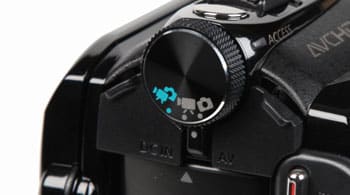
Auto Mode is confusingly called Dual Shot mode
We also weren't always impressed by the accuracy of the H300's autofocus and auto exposure systems. The camcorder struggled to focus in low light situations, and the exposure levels were often too dark for our tastes. Still, the camcorder's compact design and simple layout make it one of the less intimidating mid-range models on the market. The fact that it doesn't use AVCHD compression also makes it easier for certain consumers. You don't need special software to import videos to your computer. You can simply drag-and-drop recorded video clips directly from a memory card onto your computer for playback.
Auto Mode
{{section_header}}{{section.name}}{{/section_header}}
A nearly universal feature on today's consumer camcorders is the presence of a dedicated auto mode. On the Samsung HMX-H300, this mode is called Smart Auto, and it is activated by pressing a button inside the LCD cavity. Smart Auto is one of the most conservative auto modes we've seen, as it completely locks you out of accessing the H300's menu system. Other camcorders will offer simplified menus in dedicated auto modes, but there are some that also take the complete lock-out route that Samsung uses on the H300. With Smart Auto engaged, the camcorder also turns on its optical image stabilization and sets all controls to auto—with no way for you to change anything (unless you turn Smart Auto off).
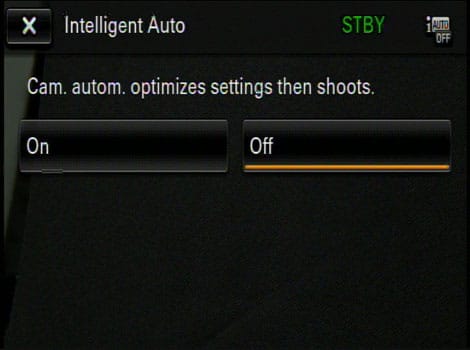
The iAuto mode button is difficult to find, but when you do find it the option for turning on the mode looks like this.
Auto Controls
{{section_header}}{{section.name}}{{/section_header}}
Automatic controls can be used on the HMX-H300 outside of the Smart Auto mode, or you can set the camcorder to Smart Auto if you want to ensure everything is being controlled manually. In the menu system, you can select controls to be set manually on an individual basis. This means, for example, you can use manual focus, but leave everything else to automatic control if you want.
The two most prominent auto controls don't work very well. The autofocus system takes far too long to function, particularly when used in conjunction with optical zoom. The auto exposure is better, but it wasn't always very accurate. At times, we found the camcorder exposing things too dimly in auto mode, and the transition from light to dark settings often gave the H300 difficulty when trying to focus.
In addition to those basic auto controls, the HMX-H300 has seven scene modes (called iScenes), four white balance presets, two low light modes (Normal C. Nite and Super C. Nite), and a 30x optical zoom. This large zoom is quite possibly one of the HMX-H300's most endearing features, as it is a longer zoom than you'll find on most mid-range HD camcorders.
Handling
{{section_header}}{{section.name}}{{/section_header}}
Samsung didn't alter the design too much on the HMX-H300 as compared to last year's HMX-H200. The camcorder still has a fairly traditional, horizontal design, although Samsung did implement a few adjustments to make its figure more streamlined. This was primarily done by smoothing out the back side of the camcorder so the battery pack fits flush with the back edge of the camcorder's body. Samsung also increased the LCD by 0.3-inches (up to 3-inches), but this increase was done without making the H300 bulkier or less comfortable to hold. In fact, the larger LCD makes the touchscreen interface a bit easier to use.

In a year where many manufacturers are cutting back on hand strap quality, the Samsung HMX-H300's simple strap design is actually better than what most mid-range camcorders offer. The strap doesn't have much padding, but it has a soft, suede-like lining on the inside of the strap that feels very comfortable against the back of your palm. The strap is also easily adjustable, and its Velcro enclosure is tighter and stronger than what we've seen on other camcorders.

The HMX-H300 is a bare bones camcorder in many ways. Its lens doesn't have an automatic cover (you have to flick a switch to open and close the lens cover), and its body isn't outfitted with any special designs or unique functions. The grip on the camcorder isn't fantastic, and our fingers didn't always line up very well with certain buttons, but the H300's design is definitely more forgiving for those with small or medium-sized hands.


These dedicated buttons give you quick access to aperture and shutter speed controls.
Portability
{{section_header}}{{section.name}}{{/section_header}}
The Samsung HMX-H300 is compact, even when compared to other mid-range HD camcorders in its price range. It weighs a little over 1/2 a pound (280g) with its provided battery pack, which is a good deal less than botht he Panasonic HDC-TM90 and the Canon HF M40.
Of course, when you consider portability, you must remember the HMX-H300 has no internal memory. This means you must pack a memory card or two along with you on your travels. Memory cards don't add much weight (just a few grams), but they are easy to lose and/or forget about. Having internal memory improves portability because it makes for one less thing you have to remember to pack.
Battery Life
{{section_header}}{{section.name}}{{/section_header}}
The Samsung HMX-H300 comes with a rechargeable battery pack that fits into the back of the camcorder. In our test, in which we let the camcorder record continuously without altering any controls, the H300's provided battery pack lasted for 177 minutes (that's just under 3 hours). This is an excellent battery life performance for a mid-range camcorder, as it is 70 minutes longer than the Panasonic TM90 lasted in this test and just over 50 minutes longer than the Canon HF M40 lasted. It also represents a half-hour increase over last year's Samsung HMX-H200, so it is clear Samsung made at least some changes to make its new camcorder more energy efficient. More on how we test battery life.
As we said earlier, the battery compartment on the H300 is on the back of the camcorder. It is also an open compartment, which means you can use larger battery packs with the camcorder if you need longer battery life. Three hours is a pretty long time for a provided battery pack to last, though, so you may not need much more than that.

{{comparison_bars title="Battery Life Comparison", attribute="Battery Life Score", xLabel="minutes"}}
LCD
{{section_header}}{{section.name}}{{/section_header}}
Samsung increased the LCD size on the HMX-H300 to 3-inches (up from 2.7-inches on last year's HMX-H200), but everything else about the screen and LCD panel remained the same. The extra size does make the touchscreen easier to use, but the system is still somewhat aggravating. The screen isn't always responsive when you press it, and it is particularly sluggish in the moments right after you stop recording a video clip.
These complaints about the touchscreens are nearly universal for consumer camcorders, nearly all of which employ touchscreen systems this day in age. The system on the HMX-H300 isn't much worse than what you get on the Panasonic HDC-TM90 or the Canon HF M40, but you do see better touchscreen LCDs on certain high-end camcorders (like the Canon HF G10). Like most mid-range camcorders, the Samsung H300 does not have a viewfinder, so all your framing and recording must be performed using the LCD.
Stabilization
{{section_header}}{{section.name}}{{/section_header}}
The HMX-H300 is equipped with an optical image stabilization (OIS) system, which is a feature found on just about half of all mid-range camcorders. Many low-end camcorders include digital stabilization systems instead of optical ones, as they are cheaper to implement, so it's good to see Samsung went with an optical system instead (OIS doesn't result in image degradation like digital stabilization can). More on how we test stabilization.
Results from our stabilization test were very good for the camcorder. In our low shake test, unwanted movement was reduced by 62% using the H300's OIS system. In the high shake test results were nearly identical, with the OIS cutting down 59% of the shake. These are both very good scores that come in slightly under what the Panasonic TM90 showed us with its OIS system. The Samsung H300 does not have multiple stabilization settings like you see on Panasonic, Canon, and Sony models, but its regular OIS mode worked perfectly fine in our testing regardless.
Manual Focus
{{section_header}}{{section.name}}{{/section_header}}
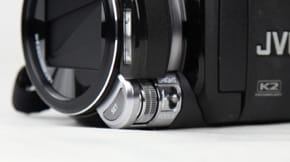
The adjustment dial makes accurate focus adjustments easy.
Manual Exposure
{{section_header}}{{section.name}}{{/section_header}}
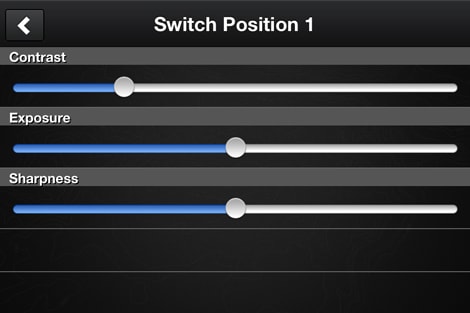
The manual exposure controls are only found on the Contour app, not on the camcorder itself.
Miscellaneous Controls
{{section_header}}{{section.name}}{{/section_header}}
Tele Macro
Alters the focus distances to make it possible to focus on close-up subjects when using lots of optical zoom.
Guideline
Displays an overlay of lines on the LCD to assist with framing during recording. Don't worry, the lines won't end up on your recorded footage (they're for display purposes only).
Auto Controls
{{section_header}}{{section.name}}{{/section_header}}
Automatic controls can be used on the HMX-H300 outside of the Smart Auto mode, or you can set the camcorder to Smart Auto if you want to ensure everything is being controlled manually. In the menu system, you can select controls to be set manually on an individual basis. This means, for example, you can use manual focus, but leave everything else to automatic control if you want.
The two most prominent auto controls don't work very well. The autofocus system takes far too long to function, particularly when used in conjunction with optical zoom. The auto exposure is better, but it wasn't always very accurate. At times, we found the camcorder exposing things too dimly in auto mode, and the transition from light to dark settings often gave the H300 difficulty when trying to focus.
In addition to those basic auto controls, the HMX-H300 has seven scene modes (called iScenes), four white balance presets, two low light modes (Normal C. Nite and Super C. Nite), and a 30x optical zoom. This large zoom is quite possibly one of the HMX-H300's most endearing features, as it is a longer zoom than you'll find on most mid-range HD camcorders.
Audio Controls
{{section_header}}{{section.name}}{{/section_header}}
The Samsung HMX-H300 has no external mic input, no headphone jack, and no manual audio level adjustment options. All it has in terms of audio features is a built-in stereo microphone (on the front of the camcorder), and a basic wind cut option that reduces the amount of wind interference captured by the internal mic.
Editing
{{section_header}}{{section.name}}{{/section_header}}
The Samsung HMX-H300 comes with Intelli-Studio software loaded on the camcorder itself. When we say the software is "on the camcorder" this doesn't mean you can use it without the aid of a computer. What it means is that you install the software by connecting the camcorder to a compatible computer (PCs only) instead of inserting a software installation disc. The Intelli-Studio software is the same software that came with the Samsung HMX-H200 last year. For an overview of the software that ships with this and other camcorders, see our article: Video Editing Software For Your Camcorder{{product.brand.name}}-Included-Software.htm.
Compression
{{section_header}}{{section.name}}{{/section_header}}
The camcorder uses the MPEG-4 codec and the H.264 compression format to record video. This is a similar system to the AVCHD compression used by most other consumer camcorder manufacturers, but the format used on the Samsung is not officially AVCHD compliant.
The Samsung HMX-H300 is a Full HD camcorder, which means it has the ability to record a 1920 x 1080 video image. In Full HD mode, the camcorder uses a 60i frame rate. Unlike most consumer camcorders, the HMX-H300 also has the ability to record 1280 x 720 HD video and 720 x 480 standard definition video (both with 60p frame rates). Most HD camcorders these days, other than Sony models, do not allow for standard definition recording, so this is a key feature for the HMX-H300 and other Samsung camcorders. At each recording resolution, the HMX-H300 offers three quality options: Super Fine, Fine, and Normal. Read more about the advantages and disadvantages of various high definition compression types.
Media
{{section_header}}{{section.name}}{{/section_header}}
There's no internal memory on the HMX-H300, so you must purchase an SD-type memory card to fit into the camcorder's card slot before you can start recording videos or taking pictures with the camcorder. The card slot works with SD or SDHC memory cards, but Samsung does not list SDXC compatibility as a feature of the HMX-H300.
The H300's sibling model, the HMX-H304 is identical to the H300, but contains 16GB of internal memory. Samsung originally announced an HMX-H304 (8GB internal memory) and HMX-H305 (32GB internal memory), but neither of these camcorders appear on Samsung's US website at this time. Read more about the advantages and disadvantages of various media types.

Slow Motion Modes
Still Features
{{section_header}}{{section.name}}{{/section_header}}
There's no separate photo mode on the HMX-H300, but we actually like that setup. If you want to take photos or adjust photo settings you don't have to switch to a different mode—it can all be performed in the dual video/photo mode (the camcorder's regular shooting mode). To take a photo, you simply press the shutter button down halfway to focus and then all the way down to snap a picture.
There are only two photo resolution options on the H300: 2944 x 1656 (4.9 megapixels) and 1920 x 1080 (2 megapixels). The good news is that neither of these size options are interpolated, as they both fall under the HMX-H300's total pixel count of 5.1 megapixels. Additional photo controls include photo sharpness adjustment (soft, normal, or sharp), a continuous shooting mode, and a 10-second self-timer.
Lens & Imaging System
{{section_header}}{{section.name}}{{/section_header}}

The lens on the HMX-H300 has a long, 30x optical zoom, which is one of the longer zooms we've seen on a mid-range HD model. The lens has no automatic cover, however, so you must remember to flick the small lens cover switch on the side of the camcorder to keep the precious lens protected when it isn't in use. The camcorder has a 1/4.1-inch sensor, which is the same size CMOS used on most mid-range HD camcorders (the Panasonic HDC-TM90 and Samsung HMX-H300 included). One mid-range model that does not use a 1/4-inch sensor is the Canon HF M40, which uses a larger, 1/3-inch sensor instead (but a smaller concentration of pixels).
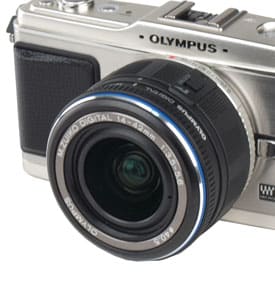
LCD
{{section_header}}{{section.name}}{{/section_header}}
Samsung increased the LCD size on the HMX-H300 to 3-inches (up from 2.7-inches on last year's HMX-H200), but everything else about the screen and LCD panel remained the same. The extra size does make the touchscreen easier to use, but the system is still somewhat aggravating. The screen isn't always responsive when you press it, and it is particularly sluggish in the moments right after you stop recording a video clip.
These complaints about the touchscreens are nearly universal for consumer camcorders, nearly all of which employ touchscreen systems this day in age. The system on the HMX-H300 isn't much worse than what you get on the Panasonic HDC-TM90 or the Canon HF M40, but you do see better touchscreen LCDs on certain high-end camcorders (like the Canon HF G10). Like most mid-range camcorders, the Samsung H300 does not have a viewfinder, so all your framing and recording must be performed using the LCD.
Connectivity
{{section_header}}{{section.name}}{{/section_header}}
The Samsung H300 isn't heavy on connectivity features, but the upside of this is that most of the camcorder's ports and jacks are located in one, easy-to-locate spot. To find them, you simply open the LCD panel and flip down the small door that is near the base of the camcorder. Opening this door you'll notice a mini HDMI port, a USB terminal, and a proprietary AV port that works with the provided AV cable. The only unique thing we must note about these ports is that the USB terminal can be used to charge the camcorder if you wish. This is a great commodity for people who are traveling with lots of USB-charging devices (like iPods, cell phones, etc.).
If you don't have a USB terminal handy to charge with, the HMX-H300 can also be powered via its DC-input. This input is located on the back of the camcorder and has its very own port cover. This cover, like the port cover inside the LCD cavity, feels reasonably strong and it has a small tab to make opening it easier. The camcorder ships with a power adapter that works with this DC-input.
The only other connectivity option on the camcorder is the memory card slot located on the right side. This slot is somewhat difficult to locate due to the placement of the camcorder's hand strap, but it does have a decent cover that protects the slot. The card slot works with SD or SDHC memory cards, but Samsung makes no claim that the H300 is compatible with new SDXC memory cards. This isn't much of an issue at this time, however, as SDXC cards are very expensive. Instead of getting on 64GB SDXC card, you're better off buying a two 32GB SDHC cards or a bunch of 16GB SDHC cards.
Battery
{{section_header}}{{section.name}}{{/section_header}}
As we said earlier, the battery compartment on the H300 is on the back of the camcorder. It is also an open compartment, which means you can use larger battery packs with the camcorder if you need longer battery life. Three hours is a pretty long time for a provided battery pack to last, though, so you may not need much more than that.

Media
{{section_header}}{{section.name}}{{/section_header}}
There's no internal memory on the HMX-H300, so you must purchase an SD-type memory card to fit into the camcorder's card slot before you can start recording videos or taking pictures with the camcorder. The card slot works with SD or SDHC memory cards, but Samsung does not list SDXC compatibility as a feature of the HMX-H300.
The H300's sibling model, the HMX-H304 is identical to the H300, but contains 16GB of internal memory. Samsung originally announced an HMX-H304 (8GB internal memory) and HMX-H305 (32GB internal memory), but neither of these camcorders appear on Samsung's US website at this time. Read more about the advantages and disadvantages of various media types.

Still Features
{{section_header}}{{section.name}}{{/section_header}}
There's no separate photo mode on the HMX-H300, but we actually like that setup. If you want to take photos or adjust photo settings you don't have to switch to a different mode—it can all be performed in the dual video/photo mode (the camcorder's regular shooting mode). To take a photo, you simply press the shutter button down halfway to focus and then all the way down to snap a picture.
There are only two photo resolution options on the H300: 2944 x 1656 (4.9 megapixels) and 1920 x 1080 (2 megapixels). The good news is that neither of these size options are interpolated, as they both fall under the HMX-H300's total pixel count of 5.1 megapixels. Additional photo controls include photo sharpness adjustment (soft, normal, or sharp), a continuous shooting mode, and a 10-second self-timer.
Other Features
{{section_header}}{{section.name}}{{/section_header}}
Time Lapse Record
Time lapse recording is a great way to capture minute movement—like a sunrise or a flower in bloom—in a fast-paced sequence. You set an interval in which the camcorder will record one frame of video over a long period of time. Interval options include every 1/2 second, 1 second, 3 seconds, or 5 seconds. Other camcorders, like certain JVC models, have more interval choices with their time lapse record modes, but the options on the HMX-H300 should be sufficient for most time lapse recordings. All videos recorded this way are captured at a 1280 x 720 resolution with the Super Fine quality setting and a 60p frame rate.
Fader
You can add a fade to your recording with this feature. Options for fading in, fading out, or fading in and out are possible.
Digital Effect
A number of digital effects can be applied to your recordings. Options include: Black & White, Sepia, Negative, Art, Ghost, Dazzle, Noir, and Western.
Canon Vixia HF M40 Comparison
The Samsung HMX-H300 may be considered a mid-range HD camcorder, but judging by our tests it certainly isn't in the same class as the Panasonic HDC-TM90 (or the Canon HF M40, for that matter). The Samsung's performance in our video testing simply did not show the same stellar results, particularly in low light, that we saw from the TM90. The HMX-H300 also lacks some of the features and controls that make the TM90 such a special mid-range camcorder (like a 1080/60p record mode and 3D capability with an optional conversion lens).
The Panasonic HDC-TM90 is more expensive than the Samsung HMX-H300, but we think the extra couple hundred dollars is worth it. With the TM90 you get 16GB of internal flash memory (as opposed to none on the HMX-H300), and the performance is so much better. The Samsung HMX-H300 is a bit simpler to use, has a longer zoom and better battery life, and it includes a standard definition record mode in addition to HD options, but those are its only advantages over the Panasonic TM90.
If you can spare the extra cash, we think most people will be happier with the Panasonic HDC-TM90 over the Samsung HMX-H300. The controls, performance, and features are all more sophisticated on the TM90, and you'll notice a big difference in low light performance if nothing else.
Samsung HMX-H200 Comparison
Like the Panasonic HDC-TM90, the Canon HF M40 is an excellent mid-range HD camcorder. Its suggested retail price is around $700, though, which makes it one of the most expensive camcorders of its class (that's $300 more than the Samsung HMX-H300). The camcorder does come with 16GB of internal flash memory, so keep that in mind when you consider the price of the model.
What makes the HF M40 great is that its CMOS sensor system is identical to that which is found in Canon's flagship model, the HF G10 (which, in turn, is identical to the sensor found in Canon's professional-line XA10 camcorder). So, in essence, the HF M40 has a professional-grade image sensor that is capable of producing excellent low light video—the best low light performance we've seen from a mid-range camcorder. The HF M40 didn't run away with the best performance in our bright light tests, but its results were still more than adequate for a camcorder of its class.
The HF M40 offers alternate frame rate options of 24p and 30p, but it has no 1080/60p record mode that you get on the Panasonic HDC-TM90 (and some Handycam models from Sony). Still, these alternate frame rate options are better than what is available on the Samsung HMX-H300, which only allows for 60i recording in its Full HD mode (and 60p when shooting 1280 x 720).
Much like the Panasonic HDC-TM90, the Canon HF M40 is in a completely different price range than the Samsung HMX-H300. Also like the TM90, however, we feel the extra cost of the HF M40 is worth it. The performance of the camcorder was wildly better than anything the Samsung HMX-H300 showed us, and the Canon offers more features, better controls, and a more sophisticated shooting experience. Like we said before, the innards of the HF M40 are essentially the same as Canon's professional XA10 camcorder, so you're getting professional video quality in a mid-range camcorder. We think $700 is a fair price to pay for that kind of quality.
COMP 3
As you can probably tell by its model name, the HMX-H300 is Samsung's replacement for last year's HMX-H200 camcorder. Samsung stuck with the idea of making a very affordable, bare-bones model, as both the H300 and H200 have no internal memory and are suggested for retail at under $400. In our testing, we found Samsung made a variety of improvements over last year's H200, but the company also took a step backwards in some areas.
Let's start with the improvements. The HMX-H300 is smaller, lighter, and has an overall better design than the HMX-H200. It also has a larger LCD than its predecessor, significantly improved battery life, and better image stabilization. All of these are welcomed improvements, particular the slight design modifications that end up making the HMX-H300 more comfortable and easier to use.
But there were also a few areas where Samsung either didn't improve anything or showed signs of a slight downgrade compared to last year's HMX-H200. The color accuracy and noise levels on the new camcorder were generally worse than last year's model, and the overall quality of the HMX-H300's low light video was actually worse than that of the HMX-H200. Basically, we wanted to see an increase in video performance and quality from the HMX-H300, but the camcorder showed us nothing of the sort.
This lack of improvement leaves us very disappointed, and makes us weary about recommending the HMX-H300 to perspective buyers. Since the low light video from the HMX-H200 actually looked better to us (and it did a bit better in our sharpness tests as well), we'd recommend looking for a cheap HMX-H200 for sale instead of going with the H300. Since it is an older model, you may be able to find it at a bargain price, and you can be confident you're getting a camcorder that is just as good, if not better, than the Samsung HMX-H300.
Conclusion
The Samsung HMX-H300 is not one of the better HD camcorders we've reviewed, even when you consider its budget-friendly $400 price tag. While Panasonic and Canon made strides in improving their mid-range HD camcorder line, Samsung stayed put, as is clear by the HMX-H300's eerie similarity to last year's HMX-H200 in both performance and design. This isn't to say the H200 is an awful camcorder—it's still a decent model, particularly when you consider its low price tag. We just think there are better camcorders, like the Panasonic HDC-TM90 and the Canon HF M40, that offer much better performance and features for just a couple hundred bucks more.
What disappointed us most about the HMX-H300, in terms of performance that is, was the fact that Samsung failed to improve the video quality on the camcorder as compared to its predecessor (the HMX-H200). In fact, the H300's video in low light looked even worse than what the H200 showed us at times, and for a new camcorder to perform worse than its predecessor is never a good thing. We did like the design improvements Samsung made, however, which include a larger LCD, tighter design, and a better hand strap, but those changes are clearly overshadowed by the camcorder's poor video image quality.
We like the HMX-H300 as a budget camcorder, but you have to keep in mind the model has no internal memory. This means you must add the cost of a memory card on top of the cost for the camcorder before you can start recording. Both the Panasonic HDC-TM90 and Canon HF M40 have 16GB of internal memory, which we think is worth around $50 for the convenience. Taking this into account makes the H300 less of a bargain, and the fact that we've seen TM90s popping up for sale on Amazon and B&H for under $450 makes it all that much more enticing.
If you can afford the extra cash, going with the Canon HF M40 or Panasonic HDC-TM90 will give you a huge upgrade over the Samsung HMX-H300 (we really can't say this enough). And if you're looking at the HMX-H300 because your on a budget, we may recommend trying to find a cheap Samsung HMX-H200 instead. After all, it was just as good (if not better) than the HMX-H300 in our video performance testing.
Photo Gallery
{{photo_gallery "Front Photo", "Left Photo", "Left Open Photo", "Back Photo", "Right Photo", "Top Photo", "Bottom Photo", "Lens Photo", "Lens Photo 2", "3D Lens Photo", "Media Photo", "Easy Mode Photo", "Manual Controls Photo", "Zoom Photo", "Zoom Photo 2", "Ease of Use Photo", "Battery Photo", "LCD Photo 1", "LCD Photo 2", "EVF Photo 1", "EVF Photo 2", "Mic Photo", "Mic Photo 2", "Ports Photo 1", "Ports Photo 2", "Ports Photo 3", "Ports Photo 4", "Ports Photo 5", "Ports Photo 6", "Handling Photo 1", "Handling Photo 2", "Handling Photo 3", "Handling Photo 4", "Box Photo"}}
Meet the tester
Jeremy is the video expert of our imaging team and Reviewed.com's head of video production. Originally from Pennsylvania and upstate NY, he graduated from Bard college with a degree in film and electronic media. He has been living and working in New England since 2005.
Checking our work.
Our team is here to help you buy the best stuff and love what you own. Our writers, editors, and experts obsess over the products we cover to make sure you're confident and satisfied. Have a different opinion about something we recommend? Email us and we'll compare notes.
Shoot us an email